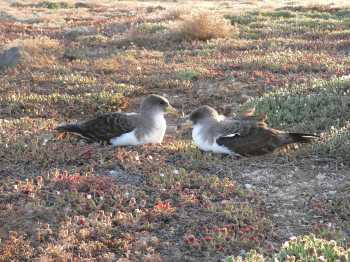Fredrik Haug (Marine and Environmental Sciences Centre, Universidade de Coimbra, Portugal) and colleagues have published this year in the journal Marine Biology on foraging differences in Cory’s Shearwaters Calonectris borealis breeding on Portugal’s Berlenga Island.
The paper’s abstract follows:
“Experience is believed to be an important factor determining the foraging success of animals, but there is limited knowledge on how foraging tactics differ among individuals, and on how individuals develop efficient foraging strategies. Pelagic seabirds are some of the longest living organisms, and in several species, breeding is deferred far beyond their physical maturity. The complex foraging skills needed to successfully rear a young is considered the most likely explanation for this life trait, making seabirds particularly interesting for the investigation of how foraging skills differ and develop through their life span. In our study, the spatial distribution and foraging tactics of experienced and inexperienced males of a Procellariiform seabird species, the Cory’s shearwater (Calonectris borealis) breeding on the Portuguese continental shelf, were compared along three consecutive breeding seasons with ameliorating environmental conditions (from 2010 towards 2012). Kernel overlaps of foraging areas and habitat modelling demonstrated that while experienced males showed high fidelity to shallow feeding grounds, inexperienced birds were more explorative and relied more on less-productive pelagic areas. Our results seem to support the prediction that differences between experienced and inexperienced individuals are enhanced by food scarcity. In fact, there was a higher spatial, trophic and behavioural segregation between both groups when environmental conditions were poor, which progressively diminished with improving environmental conditions. Still, we cannot rule out the fact that inexperienced birds might be gaining experience with each breeding season and thus honing their foraging skills towards those of experienced individuals.”

Cory's Shearwaters, photograph by Paulo Catry
Reference:
Haug, F.D., Paiva, V.H., Werner, A.C. & Ramos, J.A. 2015. Foraging by experienced and inexperienced Cory’s shearwater along a 3-year period of ameliorating foraging conditions. Marine Biology 162: 649-660.
John Cooper, ACAP Information Officer, 20 February 2015

 English
English  Français
Français  Español
Español